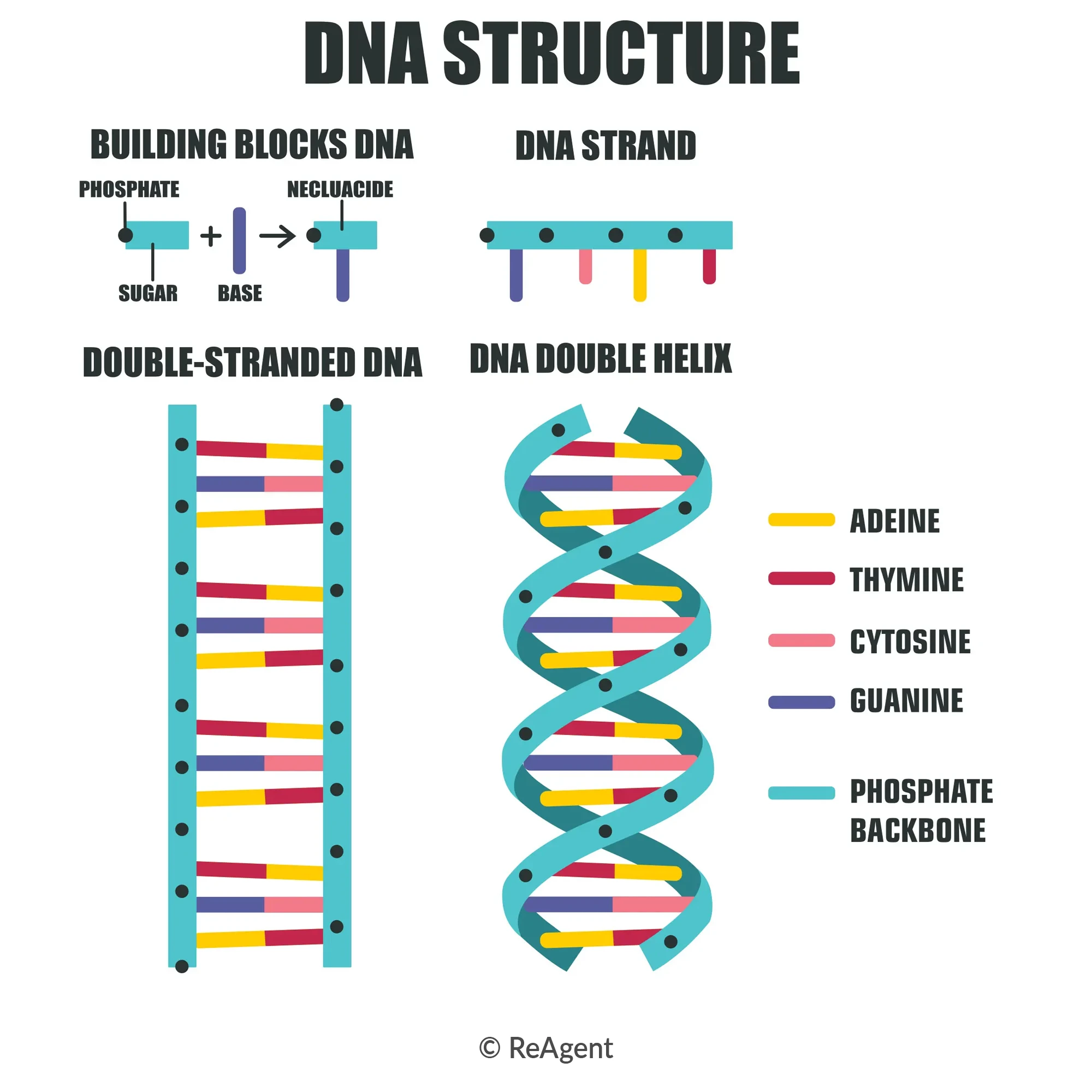History and popular culture largely credit the discovery of the structure of DNA to the American biologist James Watson and the English physicist Francis Crick. They jointly received the 1962 Nobel Prize in Physiology or Medicine, along with fellow scientist Maurice Wilkins.
However, as we explain below, Watson and Crick wouldn’t have been able to accomplish their monumental research without the help of other scientists who laid the groundwork for their discovery.
These include the British chemist Rosalind Franklin and the Swiss physician and biologist Friedrich Miescher, who first discovered the DNA molecule in 1869.
In this post:
The history of biology, DNA & genetics
The discovery of the double helix DNA structure is founded on the search for the molecular basis of biological inheritance. Charles Darwin correctly deduced the mechanism of evolution through natural selection.
 Aside from explaining how different species can descend from a common ancestor, Darwin’s idea about gemmules was the first scientific hypothesis about hereditary material found inside the cells. He hypothesised that these gemmules are emitted by every cell and can aggregate in sexual cells in the reproductive organs.
Aside from explaining how different species can descend from a common ancestor, Darwin’s idea about gemmules was the first scientific hypothesis about hereditary material found inside the cells. He hypothesised that these gemmules are emitted by every cell and can aggregate in sexual cells in the reproductive organs.
However, Darwin was wrong about the mechanism of how hereditary traits are transmitted from parents to their offspring. He believed hereditary traits could blend together; for example, a black rabbit that breeds with a white rabbit can produce offspring with grey fur.
It wasn’t until Gregor Mendel experimented with breeding pea plants that the mechanisms of genetic inheritance were established. Yet at this point, the molecule responsible for transmitting traits was still unknown.
Scientists in the 19th century believed genetic inheritance was carried by the protein molecule. Even after Johann Friedrich Miescher discovered nuclein (DNA), it took several decades before experts fully recognised its role in genetics. It was in the 1940s to 1950s that scientists like Oswald Avery and Erwin Chargaff made the connection between heredity and DNA.
Famous figures in the discovery of the structure of DNA
As Sir Isaac Newton once said, “If I have seen further, it is by standing on the shoulders of giants.” The same is true for the discovery of the DNA structure, which was only made possible through direct and indirect collaborative work by various scientists with different specialisations.
The most important and well-known scientists who made significant contributions to the discovery of the structure of DNA include the following:
- James Watson – an American biologist, geneticist and zoologist who co-discovered the double helix structure of the DNA molecule.
- Francis Crick – an English molecular biologist, neuroscientist and biophysicist. He co-discovered the DNA structure and co-authored an academic paper describing the structure.
- Rosalind Franklin – a British chemist whose X-ray crystallography data on the DNA molecule served as the basis for the modelling of the structure of DNA.
- Maurice Wilkins – a New Zealand-born British biophysicist who won the 1962 Nobel Prize in Physiology and Medicine, along with Watson and Crick. He was awarded for his research on nucleic acids and the discovery of the structure of the DNA molecule. Wilkins was one of the pioneers of X-ray diffraction techniques.
- Linus Pauling – a two-time Nobel Prize-winning American chemist, biochemist, chemical engineer, peace activist, author, and educator. Pauling proposed a three-chain helical structure of the DNA molecule. However, his model was inaccurate because he lacked crucial data.
Rosalind Franklin’s role

Some historians, scientists, and feminist activists believe Rosalind Franklin deserved to receive the Nobel Prize in Physiology or Medicine in 1962 alongside Watson, Crick, and Wilkins. Her X-ray crystallography data provided the crucial information necessary to deduce the structure of the DNA. This was particularly evident in Photo 51.
The photo was taken by Raymond Gosling, a graduate student under the supervision of Rosalind Franklin at King’s College London. The photograph is a fibre diffraction image of a paracrystalline gel composed of DNA fibre.

The image contains details that have one-to-one correspondence with the structure of the DNA molecule. The distances between the atoms and the helical structure can also be calculated based on the image.
Watson and Crick’s model
The Watson and Crick model of the DNA molecule was based on the X-ray diffraction crystallography data collected by Rosalind Franklin and the calculations made from Photo 51.
Watson and Crick realised there must be two strands of DNA forming a ladder-like double helix structure. These strands are held together by hydrogen bonds between paired nitrogenous bases.
Each pair of bases lies flat, forming a rung of the ladder. The combination of bases is specific; adenine (A) is always paired with thymine (T), while guanine (G) is always paired with cytosine (C). Sugar phosphate serves as the backbone of the molecule.
The 1962 Nobel Prize
The discovery of the DNA structure was a monumental step in biological and medicinal sciences. The landmark discovery was formally recognised by the Nobel Committee.
James Watson, Francis Crick and Maurice Wilkins were jointly awarded the prestigious Nobel Prize in Physiology or Medicine in 1962.
The impact of the discovery of DNA
The discovery of the structure of DNA has a far-reaching impact – and not just in terms of the academic and intellectual pursuit of understanding inheritance. It elucidated the fundamental mechanisms and molecular basis of Darwinian evolution and Mendelian inheritance.
In doing so, it has opened new scientific and technological fields such as genetic engineering. It’s also significantly improved the field of medicine and pharmacology, helping experts to better understand certain illnesses and diseases.
Advancements in biology and medicine
The discovery of the DNA structure has led to great advances in biological sciences and forensics. It has enabled experts to trace the evolutionary ancestry and genetic relationships of various species through genetic profiling. The science of genetics and genetic engineering has also made it possible to map the human genome.
As a result, we can now identify genetic diseases, psychological predispositions, and certain traits based on genetic profiling. This is crucial in prenatal screening and also in customising medicines. In the near future, it may even be possible to enhance human abilities and improve life expectancy, although this inevitably raises some significant ethical questions.
Conclusion
Although Watson, Crick and Wilkins were awarded the 1962 Nobel Prize in Physiology or Medicine for their research on the molecular structure of DNA, other scientists also contributed to its discovery. These include the Swiss physician and biologist Friedrich Miescher, along with the British chemist and X-ray crystallographer Rosalind Franklin. The discovery of the double helix structure of DNA has far-reaching implications for biology, forensics, medicine, and pharmacology.













